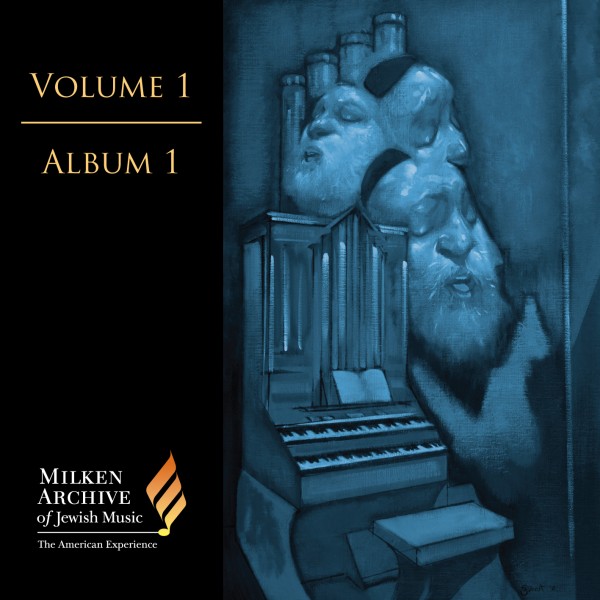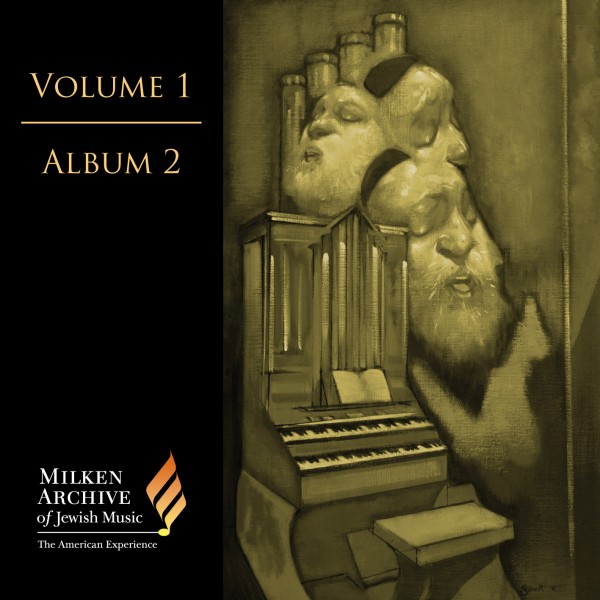Alois Kaiser was one of the first cantors to bring to America a thorough grounding in the western and Central European Ashkenazi liturgical music traditions. He came armed with knowledge of the oldest established melodies of minhag Ashkenaz (the Ashkenazi rite) and with personal experience of participation in the modern approach to traditional hazzanut (cantorial art) and its melos, and he attempted to bring these experiences to bear upon the emerging American Reform repertoire.
Kaiser was born in Szobotist, Hungary, and received his musical training in Vienna at the Teachers’ Seminary and Conservatory of Music. Of greatest significance with regard to his role in the course of 19th-century American Reform synagogue music, and especially hymnody, was his tenure in the choir of Salomon Sulzer, the architect of a refined cantorial-synagogue choral art consistent with modernity, and the prime mover in synthesizing cantorial tradition with Western artistic musical standards—paving the way for all who followed. As a boy, Kaiser sang in Sulzer’s choir at the Seitenstettengasse Tempel in Vienna and was also a de facto student of the great master. That experience gave him full working familiarity with the rich body of misinai tunes (seasonal leitmotifs, dating to medieval Rhineland Jewry) and other age-old melodies of minhag Ashkenaz, all of which Sulzer had been careful to preserve, revitalize, and incorporate into his artistic settings and into the new Wiener Ritus (Viennese rite).
By 1859 Kaiser assumed his first cantorial position, as the assistant cantor at a synagogue in the Vienna suburb of Fünfhaus. From 1863 until 1866 he was the cantor at the Neue Synagogue (New Synagoge) in Prague, after which he immigrated to the United States and assumed the cantorial post at Congregation Oheb Shalom in Baltimore. Throughout his years in America he was deeply involved beyond his own pulpit in the direction of American synagogue music in general, and for several years he was president of the Society of American Cantors, the first cantorial organization in the United States.
Kaiser joined forces with two fellow immigrant cantors, Moritz Goldstein (1840–1906) and Samuel Welsch (1835–1901), and, for one volume, with Professor I. L. Rice, who has not been identified, to compile, arrange, edit, and publish a four-volume anthology of music for the American Synagogue, Zimrath Yah—Liturgic Songs Consisting of Hebrew, English, and German Psalms and Hymns, Systematically arranged for the Jewish Rite with Organ accompaniment (self-published and issued ad seriatim between 1873 and 1886, notwithstanding the original copyright date of 1871). Goldstein, who was also born in Hungary and had been Kaiser’s fellow chorister in Sulzer’s choir in Vienna, was the son of a locally well-known eastern European hazzan in Hungary, known simply as Shmelke, who had himself been a chorister for the distinguished hazzan Dovidl Brod Strelisker (1783–1848) in Pest (Budapest). Moritz’s older brother, Josef Goldstein (1837–1899), was a prominent cantor in Hungary and Vienna (the latter from 1855 until his death). Moritz Goldstein came to America in 1868, was the cantor at New York’s Norko Synagogue for a while, and then assumed the cantorial post at B’nai Israel in Cincinnati. Welsch was born in Prague and became the cantor at New York’s Ahavath Chesed synagogue in 1865. But he returned permanently to Prague in 1880.
Zimrath Yah contains compositions by all three compiler-editors (but none by Rice), as well as a number of individual works from the published opera of such famous western/Central European synagogue composers as Sulzer and Samuel Naumbourg—though often rearranged or re-adapted and given organ accompaniments where none existed in the original. There are also some compositions by obscure or little-known composers and occasional adaptations from the few pre–modern era eastern European hazzanim whose pieces already existed in print, such as Solomon Weintraub [Kashtan] (1781–1829). The subtitle is a bit misleading, for the volumes are not confined to Psalms or hymns; the editors probably used that terminology simply to signify sacred music. In fact, a number of settings for other core parts of the liturgy—neither hymns nor Psalms—are included. Even though the orientation of all three editors was decisively Reform and geared toward the services in synagogues that had been established by German-speaking Jews, the contents of Zimrath Yah are not necessarily restricted to Reform ritual, and many of the organ accompaniments could be considered optional.
For years Kaiser lobbied for rabbinical support for a hymnbook that could be used by most if not all American congregations. He referred to that dream as a kind of “common hymnbook” even as he accepted reluctantly that there would probably never be a “book of common prayer” for American Jewry—referring to the prayerbook of the Church of England. Openly critical of American synagogue repertoire in the late 19th century—both for its poor quality and for its dearth of historical musical substance—and especially concerned for the preservation of the nearly thousand-year-old Western branch of minhag Ashkenaz he had learned in Europe, he cautioned that any new hymnal must be “an eminently Jewish hymnbook . . . in which every number will be a literary production of the highest order” and in which hymns would be “adapted to exclusively Jewish melodies.” That turned out to be far from the case.
Kaiser felt passionately that this old and sanctified corpus of authentic tunes could resonate as positively and as forcefully with American Jewry as it had done (and still did) in Europe. His implication was that the value of Jewish musical tradition should not necessarily be dismissed within Reform circles as something applicable exclusively to orthodoxy, or to Europe. “The ancient melodies, chants and tunes of the synagogue have lost none of their original charm,” he wrote in an article published in The American Hebrew in 1892, shortly after he joined the nascent Cantors Association of America, a.k.a. the Society of American Cantors. “And while in order to adapt them to modern tastes, we may have to clothe them in a new garb”—by which he meant restylization, reharmonization, and adaptations to Reform liturgical and ritual adjustments, including even English versions—“yet they still retain their former power.” That conviction, acknowledging the probable need to ensure preservation by adaptation to modern sensibilities, was indeed an echo of his mentor, Sulzer—a reverberation of Sulzer’s stated purpose in the published preface to his own magnum opus, Schir Zion I (ca. 1838). Moreover, Kaiser saw it as the American cantorate’s collective duty to assume this task: “If the Cantors Association will help to redeem them [those tunes] for the American Synagogue, it will do enough to earn the lasting gratitude of Israel.”
Kaiser’s opportunity came when a committee of Jewish women from prominent Chicago families invited him and Cantor William Sparger of New York’s Temple Emanu-El jointly to compile and edit a souvenir book of Jewish music (old and new) for the Jewish Women’s Congress of the World’s Parliament of Religions at the 1893 Columbian Exposition (World’s Fair) in Chicago. The result, Songs of Zion: A Collection of the Principal Melodies of the Synagogue from the Earliest Time to the Present, was distributed at the World’s Fair and then published in Chicago that same year by the Jewish Women’s Congress. Its main section offers fifty-seven well-established tunes, biblical cantillation motifs, and even modal prayer patterns and formulas of the authentic Ashkenazi tradition, with a few tunes added from Western Sephardi—the so-called Portuguese—custom. But all these examples, including those that were originally nonmetrical and rhythmically free, are stylized within metrical quasi-hymn structures, with some modal/tonal adjustments as well. In their introduction, Kaiser and Sparger acknowledge their assumption that such recasting in contemporary guises was necessary for acceptance by modern American worshippers. They note that they have undertaken to “plant it [the musical tradition] again in the synagogue and home of our people in the only form in which this can be achieved now, in the form of hymns,” alluding to resistance to cantorially rendered t’fillot. This was the “new clothing” to which Kaiser referred in his earlier article. He had accepted as an article of faith that the American Reform service would necessarily revolve around Western-style hymn singing.
Kaiser and Sparger’s volume is a curiosity today for another reason. The melodies and chants have been adapted to newly created, flowery, and sometimes grandiose English lyrics that seem hopelessly dated now. That represented another manifestation of the “new garb.” In his preface, Dr. Cyrus Adler, the eminent Judaic scholar and future president of the Jewish Theological Seminary of America, observed that the editors had in fact been “embarrassed by the necessity, in many cases, of preparing an English text to suit the music.” Still, the work as a whole had more than historical value. It introduced nonorthodox American Ashkenazi Jewry to a host of age-old, genuine melodies that were otherwise nowhere to be found in print in the United States—even including the first American notations of home ritual elements such as Sabbath z’mirot (table hymns) and seder tunes, as well as many parts of the synagogue liturgy that had become all but forgotten outside orthodoxy. Part II of the volume included representative classical, original liturgical compositions, some of them on traditional musical themes, by the reigning western and Central European synagogue composers of the modern era, such as Sulzer, Louis Lewandowski, and Samuel Naumbourg. In addition there are two settings by A. J. Davis, an organist at Temple Emanu-El, and a few by Kaiser himself.
Eventually the Central Conference of American Rabbis (the rabbinical arm of the official Reform movement), which had made Kaiser an honorary member, invited him to create and edit a new unified hymnal that would correspond to its new Union Prayerbook (1894)—soon to become the standard prayerbook of nearly all American Reform congregations (with subsequent reeditions) until at least the late 1960s. Thus was born the first edition of the Union Hymnal, which was published in 1897. Although nowhere indicated in the hymnal, it is generally known that Sparger worked together with Kaiser in editing it.
In that first Union Hymnal, Kaiser once again seized the opportunity to reassert some measure of tradition, even though it was usually camouflaged within hymn structures that were alien to the original melodies. It was, for him, “high time to revive and cultivate anew,” as he had written previously—again following Sulzer’s ideal. In the end, however, concessions to popular as well as institutional and even Reform rabbinical expectations seem to have dictated compromise. Despite Kaiser’s earlier position vis-à-vis “Jewish sources,” that hymnal contains adaptations from non-Jewish secular classical pieces by French, German, and English composers; and there are many selections with no traditional bases. But there are also a number of Kaiser’s own contributions, quite a few of which were adapted from authentic Ashkenazi tradition in order to render at least the melodies clearly recognizable to those who might have had some familiarity with their source. For others—admittedly, for most worshippers—that might have amounted to an academic exercise on Kaiser’s part, but at least he had begun the process of restoration, which was continued in the later, 20th-century editions of the Union Hymnal. That path clearly reflected Kaiser’s convictions, enunciated in his earlier plea not to forsake the traditional melos of Ashkenaz, when he wrote:
These songs of Zion, they are our heritage, entrusted to our care and cultivation. Let us zealously preserve them, for we are their watchmen and guardians. We have brought them with us from across the seas; let us imbed them firmly in the hearts of our American brethren, that they may abide there forever.
Kaiser also published a number of individual synagogue pieces during his American years. Among them are his Simchat Torahcantata; Requiem for the Day of Atonement; a collection of Confirmation hymns in German and English; music for the Passover Haggada; and various Psalm settings. By the end of the 19th century he was certainly one of the most respected leaders of synagogue music development in America, and arguably the most learned.
By: Neil W. Levin

